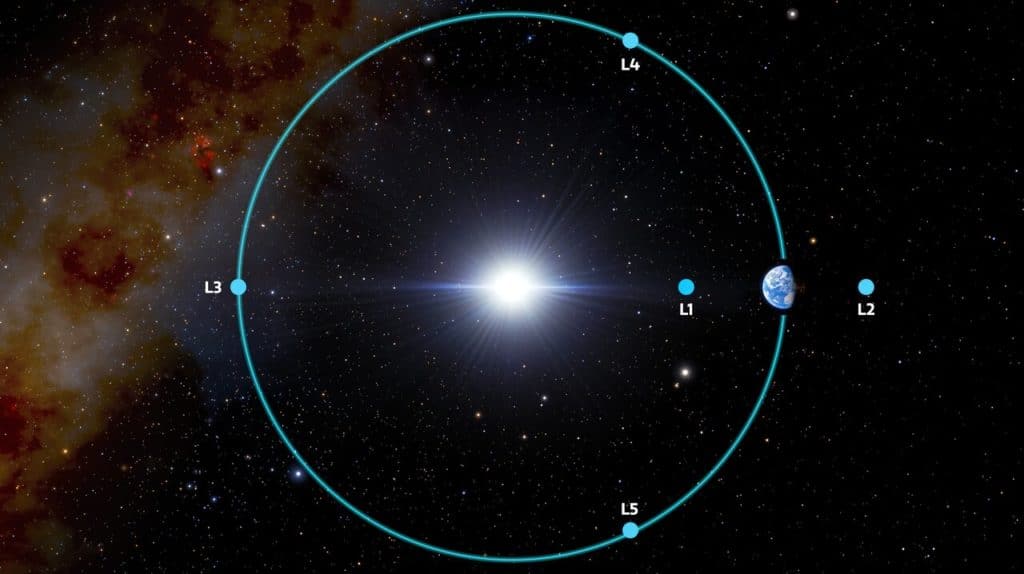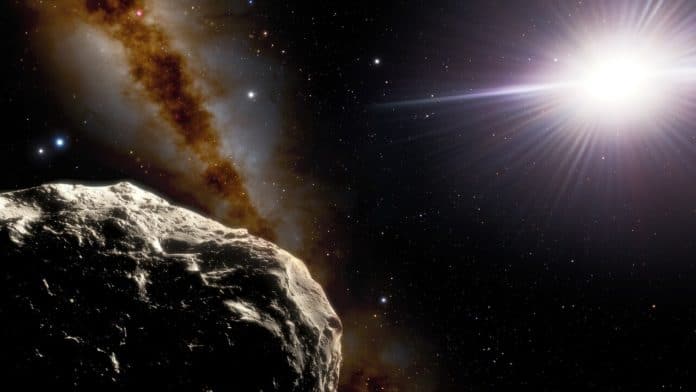By scanning the sky very close to the horizon at sunrise, the SOAR Telescope in Chile, part of Cerro-Tololo Inter-American Observatory, a Program of NSF’s NOIRLab, has helped astronomers confirm the existence of only the second-known Earth Trojan asteroid and reveals that it is over a kilometer wide — about three times larger than the first.
Using the 4.1-meter SOAR (Southern Astrophysical Research) Telescope on Cerro Pachón in Chile, astronomers led by Toni Santana-Ros of the University of Alicante and the Institute of Cosmos Sciences of the University of Barcelona observed the recently discovered asteroid 2020 XL5 to constrain its orbit and size. Their results confirm that 2020 XL5 is an Earth Trojan — an asteroid companion to Earth that orbits the Sun along the same path as our planet does — and that it is the largest one yet found.
“Trojans are objects sharing an orbit with a planet, clustered around one of two special gravitationally balanced areas along the orbit of the planet known as Lagrange points,” says Cesar Briceño of NSF’s NOIRLab, who is one of the authors of a paper published today in Nature Communications reporting the results, and who helped make the observations with the SOAR Telescope at Cerro Tololo Inter-American Observatory (CTIO), a Program of NSF’s NOIRLab, in March 2021.
Several planets in the Solar System are known to have Trojan asteroids, but 2020 XL5 is only the second known Trojan asteroid found near Earth.
Observations of 2020 XL5 were also made with the 4.3-meter Lowell Discovery Telescope at Lowell Observatory in Arizona and by the European Space Agency’s 1-meter Optical Ground Station in Tenerife in the Canary Islands.
Discovered on 12 December 2020 by the Pan-STARRS1 survey telescope in Hawai‘i, 2020 XL5 is much larger than the first Earth Trojan discovered, called 2010 TK7. The researchers found that 2020 XL5 is about 1.2 kilometers (0.73 miles) in diameter, about three times as wide as the first (2010 TK7 is estimated to be less than 400 meters or yards across).
When 2020 XL5 was discovered, its orbit around the Sun was not known well enough to say whether it was merely a near-Earth asteroid crossing our orbit, or whether it was a true Trojan. SOAR’s measurements were so accurate that Santana-Ros’s team was then able to go back and search for 2020 XL5 in archival images from 2012 to 2019 taken as part of the Dark Energy Survey using the Dark Energy Camera (DECam) on the Víctor M. Blanco 4-meter Telescope located at CTIO in Chile. With almost 10 years of data on hand, the team was able to vastly improve our understanding of the asteroid’s orbit.
Although other studies have supported the Trojan asteroid’s identification, the new results make that determination far more robust and provide estimates of the size of 2020 XL5 and what type of asteroid it is.
“SOAR’s data allowed us to make a first photometric analysis of the object, revealing that 2020 XL5 is likely a C-type asteroid, with a size larger than one kilometer,” says Santana-Ros. A C-type asteroid is dark, contains a lot of carbon, and is the most common type of asteroid in the Solar System.
The findings also showed that 2020 XL5 will not remain a Trojan asteroid forever. It will remain stable in its position for at least another 4000 years, but eventually it will be gravitationally perturbed and escape to wander through space.
2020 XL5 and 2010 TK7 may not be alone — there could be many more Earth Trojans that have so far gone undetected as they appear close to the Sun in the sky. This means that searches for, and observations of, Earth Trojans must be performed close to sunrise or sunset, with the telescope pointing near the horizon, through the thickest part of the atmosphere, which results in poor seeing conditions. SOAR was able to point down to 16 degrees above the horizon, while many 4-meter (and larger) telescopes are not able to aim that low.
“These were very challenging observations, requiring the telescope to track correctly at its lowest elevation limit, as the object was very low on the western horizon at dawn,” says Briceño.
Nevertheless, the prize of discovering Earth Trojans is worth the effort of finding them. Because they are made of primitive material dating back to the birth of the Solar System and could represent some of the building blocks that formed our planet, they are attractive targets for future space missions.
“If we are able to discover more Earth Trojans, and if some of them can have orbits with lower inclinations, they might become cheaper to reach than our Moon,” says Briceño. “So they might become ideal bases for an advanced exploration of the Solar System, or they could even be a source of resources.”

Journal Reference:
- Santana-Ros, T., Micheli, M., Faggioli, L. et al. Orbital stability analysis and photometric characterization of the second Earth Trojan asteroid 2020 XL5. Nat Commun 13, 447 (2022). DOI: 10.1038/s41467-022-27988-4
